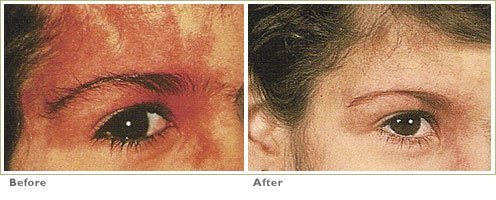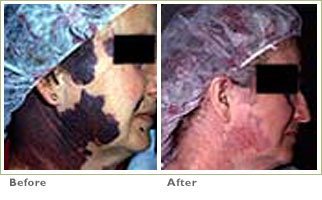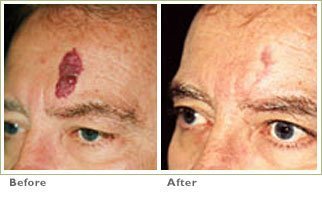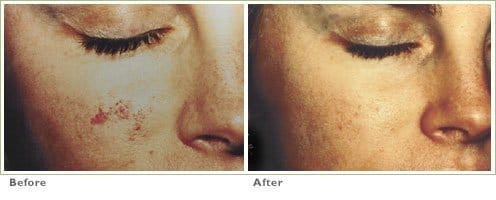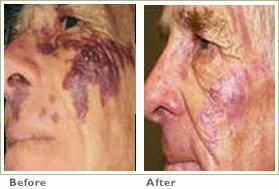Vbeam® Laser in California
Whether you are looking for spider vein or rosacea laser treatments near you, Berman Skin Institute has the solution. The Vbeam® Laser treatment evens skin tone and reduces signs of aging, making it the perfect choice for treating rosacea, scars, spider veins, sun damage and more. It is minimally invasive, low-pain and a fast enough procedure that you can get it on your lunch break — and still have time to spare!
How It Works
The Vbeam® Laser is a pulsed dye laser that delivers targeted energy to the red blood cells in your vessels — specifically, the hemoglobin in those cells. The dyed light and targeted structures ensure that the only tissue sections that experiences any effects are the ones we address. As the laser interacts with the hemoglobin, the body is signaled to break down the affected vessels until they’re ultimately flushed out through the lymphatic system.
What Are the Benefits of the Vbeam® Laser?
At Berman Skin Institute, the Vbeam® Laser is one of our favorites, as it works fast and our clients love the results. Some of the top benefits of Vbeam® Laser treatments include:
- Versatile care: Any aesthetic concerns caused by blood vessels may be a candidate for this procedure, including red birthmarks, rosacea, spider veins and more. We can even combat a number of concerns simultaneously.
- Minimal discomfort: You won’t need an anesthetic to get through this treatment. Some liken the feeling to a rubber band snapping on the skin, but many more say it’s even less painful than that. Plus, the Vbeam® Laser has a built-in cooling feature to further minimize discomfort.
- Immediate recovery: Once you’re done, you can go straight back to your routine as usual. We call this a “lunch-break friendly” procedure because you can have it done in a few minutes with little to no side effects. You can even wear makeup right after!
Vbeam® Laser Treats:
Don’t see your condition listed? Berman Skin Institute offers a comprehensive selection of skincare procedures to correct a range of concerns. Contact our team directly to learn more about what options exist for your specific needs.
V Beam Pulsed Dye Laser Gallery
V Beam Pulsed Dye Laser for Red Birthmarks
*Results may vary.
Why Choose Berman Skin Institute?
Berman Skin Institute brings decades of service and experience to every client we work with. Our providers are passionate about skincare and dedicated to helping you achieve the results you want. We pride ourselves on our patient-centric approach, ensuring we use the latest technology and treatments to deliver expert solutions.
Schedule a Vbeam® Laser Treatment Near You Today
Get natural-looking outcomes for any aesthetic concerns sooner than you thought possible that last longer than ever before. Request an in-person or virtual consultation today — we often have same- and next-day appointments available!
Frequently Asked Questions
Have more questions? These FAQs may help. Feel free to contact our providers for more information.
Who is a Candidate?
Anyone with keloid or elevated scars.
What Can I Expect During this Treatment?
The treatment of keloid and hypertrophic scars is one that has challenged clinicians for generations and continues to do so today. Even with the bank of knowledge that continuing research into the cause of these scars has provided, there is still a lack of treatment options that are infallible. Management must be tailored to each individual in turn and take into account several important factors such as the age of the scar, its size, location and thickness. However, even taking into account these factors, it is impossible to predict an individual’s response to a certain treatment. With so many treatments currently available, it is common for more than one modality to be used in the treatment of one patient’s scars.
What is the Recovery Time?
None
Does it Hurt?
Minimal discomfort is noted.
Who Performs the Treatments?
Our Physicians, Physician Assistants and Nurses
What Are the Side Effects of Vbeam® Laser Treatments?
Most side effects of using the Vbeam® Laser for broken capillaries are minor and disappear within a few hours of treatment. While many people experience no side effects at all, you should prepare yourself for sunburn-like symptoms around the treated area, such as:
- Swelling
- Redness, discoloration or bruising
- Tenderness or sore spots
Whether you experience side effects or not, try to avoid direct sun exposure in the week following your procedure. This will prevent skin irritation and lessen any sensitivity.
When Can I Expect to See Results From Vbeam® Laser Treatments?
Over the days following your appointment, you should start to see your concerns fade. It can take up to two weeks to see the full effect. Depending on the severity of your situation, you may need multiple treatments to get your desired results.



